Welcome to the second Boaters’ Update of the year. In it you’ll find:
Boaters' Update 31 January 2025
Working for boaters, storms, spiders, boating the right way, boaters' app, and more, all in latest edition.
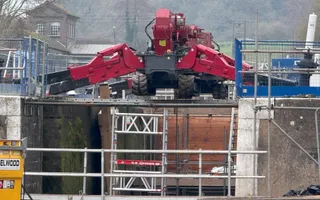
- Working for boaters
- Spiders at Hatton
- Éowyn and Herminia pick up where Darragh left off
- Vandalism undermines storm response and winter works
- Bridgewater Canal update
- Taking care of our historic structures
- Canals to form part of Government’s response to climate change
- Working for boaters – in numbers
- Maintenance, repair and restoration work this weekend
- Boaters’ smartphone app
- Our Chief Executive Richard Parry to stand down this summer
Damian
PS Don’t forget the new legal requirements for waste separation that are coming to all Trust sites in England as a result of the government’s new Simpler Recycling legislation. More information can be found on our rubbish and recycling page.
Working for boaters
If you’ve been out on the cut since the turn of the new year you’ll have seen teams all around the network busily working on one or other winter stoppage project – the programme which takes place between November and March when the canals are quieter, to minimise the impact on navigation. These works, sometimes significant engineering projects, are the core of our year-round maintenance work. A host of important repair, heritage and conservation tasks are being carried out at 159 sites across England and Wales. I visited one such project that has just got underway:
Spiders at Hatton
A popular flight of locks, that many of you will be familiar with, is getting £269,000 of TLC at Lock 40. On a grey and cold January day, I met up with Matt Davis, site supervisor, and Hayley Harper, design and development manager, to talk about spiders (cranes), gate replacement and open days:
In February we'd love you to visit one of our Open Days and learn more about how we repair and care for canals. We've already hosted one at Leeds Lock which took place in November but we have two more confirmed at Caen Hill, near Devizes and Hatton (as mentioned in the video above) in Warwickshire. Find out more here.
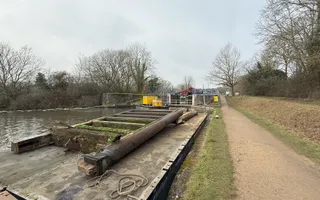
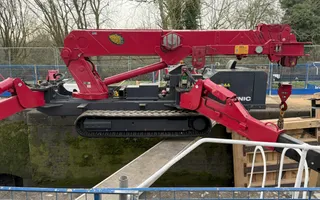
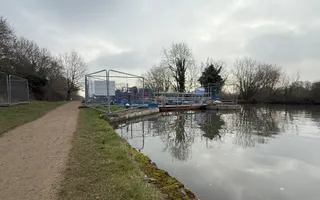
Old gates at Lock 40, Hatton, offer a prime feeding ground for birds before being recycled.
Éowyn and Herminia pick up where Darragh left off
It’s easy to recall the damage caused by Storm Darragh back in December. In fact, we’re still working on removing some trees that were felled by it – a combination of inaccessibility, continuing stormy weather and prioritising those that have the biggest impact on navigation means that, although we’re not out of the woods yet (pun intended) in terms of weather, we’re getting through the list as quickly as we can. Thanks to all of you who have helped identify where we need to be most.
Of course, after a relatively benign festive period, we could have been forgiven for hoping the worst of the winter was done. Sadly not. In fact, the Met Office said last week’s Storm Éowyn was the most intense storm for some areas of the UK for 20-30 years. With such a powerful storm ravaging most parts of the country it’ll come as no surprise that the centuries-old canal network didn’t emerge from it unscathed.
Wind caused by far the most damage. A barrier at bridge 20 (Coxhead Swing Bridge) on the Leeds & Liverpool Canal sheared off leaving the bridge unsafe and inoperable. Elsewhere the main impacts were from fallen trees. A small selection of the waterways affected include:
- Grand Union Canal
- Shropshire Union Canal
- Lancaster Canal
- Llangollen Canal
- Monmouthshire & Brecon Canal
- Sheffield & South Yorkshire Navigations
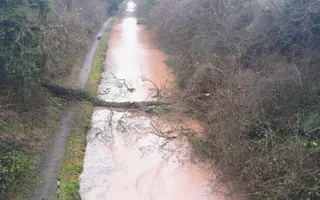
Vandalism undermines storm response and winter works
The Huddersfield Broad Canal also had windblown trees in between Locks 3 and 4 but, more frustratingly, time also now has to be spent at Lock 1 due to vandalism which damaged the gate so severely that it is no longer operable.
Equal frustrations could be found on the Oxford and Grand Union canals. On the former, a vehicle hit Bridge 110 (Stockton Road Bridge) causing it to crack, which we need to repair as soon as possible to ensure safety. On the latter, some have reportedly thrown large household furniture and furnishings into the cut near Bridge 114 in Leighton Buzzard. We are sorry that boaters have to face these unnecessary obstructions.

Bridgewater Canal update
As many of you know, on 1 January, the Bridgewater Canal, owned and operated by The Bridgewater Canal Company Limited, suffered a breach. Temporary dams were installed and operatives have been carrying out welfare checks on the boaters affected.
Starting a couple of weeks ago, the drained parts of the canal, including the moorings at Ye Old No. 3, naturally started to slowly refill over the following days. On Monday 20 January a controlled syphoning commenced, with close supervision by Bridgewater Canal Company operatives.
Earlier this week it was confirmed that the controlled syphoning of water to refill the canal, west of the breach, including the moorings at Ye Olde No. 3 has completed and all boats are refloated.
As the water level has returned to this section, stoplogs were removed from Agden, enabling boats to leave the site if they wish.
Please note, the use of the winding hole at Little Bollington is strictly prohibited until the installation of safety measures, to prevent any damage of the dams by turning boats. Materials are on order, and BCC hope to have the safety measures installed by tomorrow, 1 February.
Refilling of the canal, west of the breach
Controlled syphoning of water to refill the canal in this section has commenced earlier this week and may take up to 14 days.
For more information please visit the BCC website.
Taking care of our historic structures
The snippets above summarise just some of the challenges the network faces; increasingly frequent extreme weather, vandalism and fly tipping are added pressures on the money we use to care for the canal network.
Fiona Burt, one of your representatives on our Council, says that no matter how long you’ve been boating there are always more ways, as a boater, to learn how to take better care of the network:
“I’ve been boating since the ‘70s and I thought I knew one end of a windlass from another, but it turns out I was wrong.
“Recently, I was told that I might be damaging the paddle mechanisms by using the incorrect hole. So, I got out my trusty windlass and took a good look.
“You see, it isn’t a ‘big hole’ and a ‘small hole’. It’s a ‘straight hole’ and a ‘tapered hole’. Look at the two sides of your windlass and you’ll see what I mean.
“Apparently, using the straight hole on tapered mechanisms can cause problems. And this really is a problem, because, when we moved on board, my husband kindly bought me a Lockmaster ratchet windlass for those occasions when the paddle is too stiff for me to manage on my own (you see, chivalry is not dead, after all). This hefty windlass with extra torque only has a straight hole, so it’s really only suitable for use on straight mechanisms such as those found on the Hatton flight where I’ve incidentally never had a problem because the hydraulic systems might be tedious, but they’re easy to turn.
“We all want to preserve our canal heritage assets and no one wants extra stoppages to replace paddle mechanisms that have been forced by people using the wrong windlass.
“So, from now on, I’ll be making sure I’m using the correct hole for the mechanism. And if the paddle is too stiff, I’ll be calling my husband to help. And if he can’t shift it, then we’ll be phoning the Trust to report it.
“Incidentally, we’re also taking more care of the lock gates on the Grand Union since we discovered that the leaky bottom gates we all complain about are, in part, caused by narrow boats like ourselves lazily opening only one gate. You can see the wear a foot above the waterline from hundreds of rubbing strakes each removing a micron of wood. These wide locks were originally designed to be used by a working pair of boats that would always have to open both gates. We boaters need to take good care of our historic structures and be mindful of using them properly.”
Fiona Burt nb Lutra Lutra

Canals to form part of Government’s response to climate change
Originally a superhighway for industry and now enjoyed by millions – whether afloat or from the towpath – the waterways continue to evolve and their role in responding to climate change is being officially highlighted to government. We’ve submitted our first Climate Adaptation Report, putting us among the major infrastructure providers that report to Government about managing climate risk.
As you no doubt already know, the canal network was the most important infrastructure project of its day, making the Industrial Revolution possible. A legacy of that pioneering engineering, today’s navigable canals continue to be repurposed and, as we explain to government and others, are at the heart of many communities, providing a range of economic, social and environmental benefits on the doorstep of around ten million people.
The places around canals have also changed beyond recognition and continue to be a focus for development and regeneration, making the canal network an enabler for growth. Meanwhile, the canals themselves are vital conduits for critical national infrastructure including pipes and cables for the UK’s energy, telecommunications and water supply networks.
But, with most of the canal network built more than 200 years ago, we also report that whilst the network has a vital role to play in mitigating climate change it is also vulnerable to the changes in climate and extreme weather events of the 21st century.
The Climate Adaptation Report provides evidence into how climate change affects the canal network and its associated structures and habitats, now and in the future. It shares the top 12 biggest risks, including flooding, drought, subsidence, structural damage and ecological degradation, and describes how we manage them, illustrated by case studies.
In helping to mitigate the impacts of climate change, the Report shows how, for example, the canal network could deliver more water to areas that will experience significant water deficit in the years to come and, during storms, how canals will move flash floods away to reduce risk to neighbouring properties. In towns and cities canals will mitigate urban heat island effects, lowering temperatures and improving quality of life, while the canal network protects many households, businesses and national infrastructure such as electricity sub-stations, transport and schools.
Richard Parry, chief executive, said: “Our historic canal network fulfils a range of uses far beyond what was anticipated when the canals were first dug by hand. Many people don’t realise that these manmade waterways carry out so many important functions and need constant care and maintenance to keep them open and available to all.
“Linking towns and cities across the country and on the doorstep of millions of people, it is important for canals to be part of Government’s national climate change reporting framework. The challenge of keeping this network resilient and safe in the face of rising climate impact will require ongoing investment but it will deliver many times more benefit to society as we collectively face this unprecedented challenge.”
Richard continued: “The recent storms and floods show just how vulnerable canals, and surrounding communities, can be, and how vital it is to keep them safe. Our charity is calling on the public to help us respond to this threat and make a vital contribution towards maintaining the canal network, ensuring people can continue to use and enjoy the canals for generations to come.”
In case you’d forgotten the scale of our network, it includes:
- 2,000 miles of waterways
- 82 reservoirs (of which 71 are large, raised reservoirs subject to the Reservoirs Act 1975), four inland ports
- Over 10,000 principal assets, made up of bridges, aqueducts, tunnels, embankments, a tidal barrage and nationally and internationally designated wildlife sites.
Our core activities are to protect, operate and manage the canal network in England and Wales for navigation, access along the towpaths, and to provide recreation and other leisure activities. Beyond this, the canal network also provides essential services for others, including:
- Water transfer & supply: sustainable water transfers through partnerships with water companies, securing drinking water needs and other water dependent services, while reducing the UK’s need for new reservoirs to be constructed.
- Flood mitigation & relief: an adaptable resource to mitigate extreme weather impacts and divert water away from heavily affected areas.
- Heating & cooling: low-carbon heating and cooling of buildings and other infrastructure, such as data centres.
- Firefighting: the emergency services use water from the canal network through agreed abstraction licences or direct use in emergency situations.
- Growth & regeneration: attractive settings for sustainable urban living, active travel and urban cooling in our cities.
- Agricultural support: the canal network provides surplus water to farmers, aiding drought resilience and securing water supplies that are essential for sustaining agriculture.
Read the Climate Adaptation Report online here: Response to climate change | Canal & River Trust

Working for boaters – in numbers
With over 2,000 miles of canals and rivers, a list of all the things we’ve been doing over the last fortnight to keep navigations open would be tediously long, but a scan of our stoppage notifications shows that we’ve…
| Description | In the last fortnight | Since we started reporting (12 July 2024) |
| Removed wind-blown trees that were impeding navigation | 11 | 173 |
| Carried out general lock repairs such as repairing quoins and brickwork | 8 | 111 |
| Repaired bridges | 5 | 61 |
| Repaired Elsans | 4 | 23 |
| Carried out boater safety activities (such as placing buoys around hazards etc.) | 4 | 19 |
| Repaired pump out stations | 2 | 35 |
| Fixed customer service facilities (such as toilets) | 2 | 26 |
| Fixed lock paddles | 1 | 31 |
| Fixed (or in the process of fixing) embankments | 1 | 31 |
| Carried out dive survey/repair | 1 | 24 |
| Lock gate replacement | 1 | 16 |
| Repaired sluices | 1 | 15 |
| Annoyingly had to clear illegal fly tipping (well, one that required a stoppage, there were plenty more!) | 1 | 2 |
| Conducted/facilitated bridge inspections | 19 | 178 |
The above list doesn’t include any work conducted purely on towpaths, water management (which there’s always a lot of!), major reservoir projects and so on – it’s just a flavour of what we’ve been doing to help boaters keep moving on the cut!
Maintenance, repair and restoration work this weekend
As you’ll know there are times when we need to fix things that unexpectedly break. Of course, you’ll notice that the list below is much longer now that we’re in the winter stoppage season! So, below, you’ll find a list of navigations that have ongoing restrictions that may affect you if you’re planning to get out on the water this weekend:
- Aire & Calder Navigation
- Bridgwater & Taunton Canal
- Calder & Hebble Navigation
- Caldon Canal
- Chesterfield Canal
- Dudley No 2 Canal
- Fossdyke Canal
- Grand Union Canal
- Huddersfield Broad Canal
- Huddersfield Narrow Canal
- Kennet & Avon Canal
- Lancaster Canal
- Leeds & Liverpool Canal
- Liverpool Link
- Llangollen Canal
- Macclesfield Canal
- Monmouthshire & Brecon Canal
- Montgomery Canal
- New Mainline
- Old Main Line
- Old River Lea
- Oxford Canal
- Peak Forest Canal
- Ribble Link
- River Severn Navigation
- River Soar
- Sheffield & Tinsley Canal
- Shropshire Union Canal
- Trent & Mersey Canal
- Upper Trent
- Walsall Canal
- Weaver Navigation
- Worcester & Birmingham Canal
When restrictions to navigation happen, we get them up on to our website as soon as we can – always best to have a scan before you set off. You can find out how to get stoppage notification alerts on your smartphone in this article.
If you have any questions about a specific closure, or spot an error in our system, please get in touch.
Boaters’ smartphone app
As many of you will remember we set out our Better Boating Plan last November in response to feedback from boaters. The plan will prioritise things that will improve navigation and target issues that will make the experience of boaters better.
One of the founding principles of the Plan was that we’d develop a Boater App to make it easier for boaters to access the online services provided by us when and where they want. For example, you'll be able to report faults and find out what has been reported already.
To this end, in 2024’s final edition of Boaters’ Update, we asked for your views via a survey. Big thanks to the 574 people who took part! Your answers will help us develop an app that meets the needs of the many boaters who use smartphones and tablets on their boats (but don't worry if you're not one of them – the app will be in addition to rather than instead of any of the website's current functions). Here are some of the findings:
- 96% of respondents have smartphones on board, with a slight preference for Android devices (59%) over iOS (43%)
- 90% say they can typically access the internet most days when boating, and 92% regularly use apps in their everyday lives
- The main things people want to use the app for are searching for stoppage notices, accessing the latest reports on faults and incidents, and reporting faults and incidents
We’re now working with an advisory group of boaters to set out a detailed plan of requirements for the app, ready to start building it later this year. As it progresses you’ll be able to read updates on these pages!

Our Chief Executive Richard Parry to stand down this summer
Last week we shared the decision by Richard Parry to stand down from his role as chief executive this summer after serving 12 years in the post. A recruitment process for our next chief executive is underway
Richard joined us in 2013, a year after our creation, and has led us through our critical formative years to become an established and well-supported national charity.
It has been an honour
Richard comments: “It has been an honour to lead the Trust through such a key period, working to build a sustainable future for our historic canal network, increasing the number of people benefiting from it and wider appreciation of its value to the nation. I have loved working with such committed colleagues and a rising number of amazing volunteers who together deliver the ongoing care that the 250-year-old canal infrastructure demands – and making so many friends amongst those who use our canals and share our passion for them.
“After 12 years it is the right time for me to hand over to a new chief executive to lead the Trust on the next stage of its journey, alongside our Chair, David Orr CBE who took up his post two years ago. My departure this summer will fit into a cycle of succession, so that David and the new chief executive can look to the longer-term future, including strengthening the Trust’s partnership with Government with over four years of the current parliamentary term to run.
“There is a huge amount of work for the Trust to do over the coming months and I will be focusing all my efforts on delivering our priorities until I hand over later this summer.”
A fantastic contribution
David Orr comments: “Richard has made a fantastic contribution, establishing the Trust as a much-admired national charity. He has led the organisation through many challenges and chalked up many achievements over the past 12 years. He has been dedicated to the national treasure that is our canal network, venturing across the country to be a visible, engaging leader.
“We face many more challenges in the years ahead, and the Board and I will be looking to recruit a successor of the calibre needed to follow on from Richard, to take the Trust forward on the next phase in our journey, to grasp the wonderful opportunities we have to use our canals to support many of our national priorities and improve the lives of millions of people.”
We would like to thank you for the kind messages that many of you have posted on our social channels in response to Richard’s announcement.
Last Edited: 31 January 2025
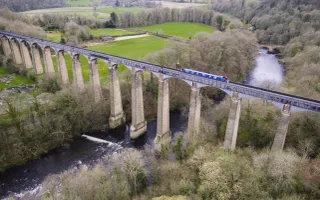

Stay connected
Sign up to our newsletter and discover how we protect canals and help nature thrive

